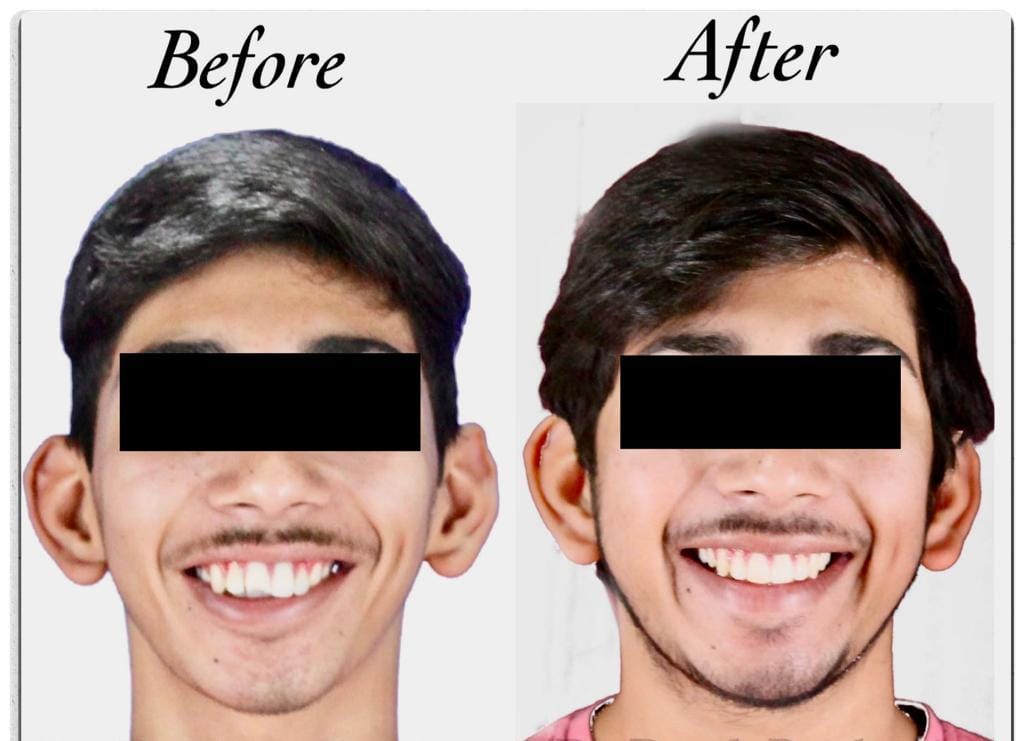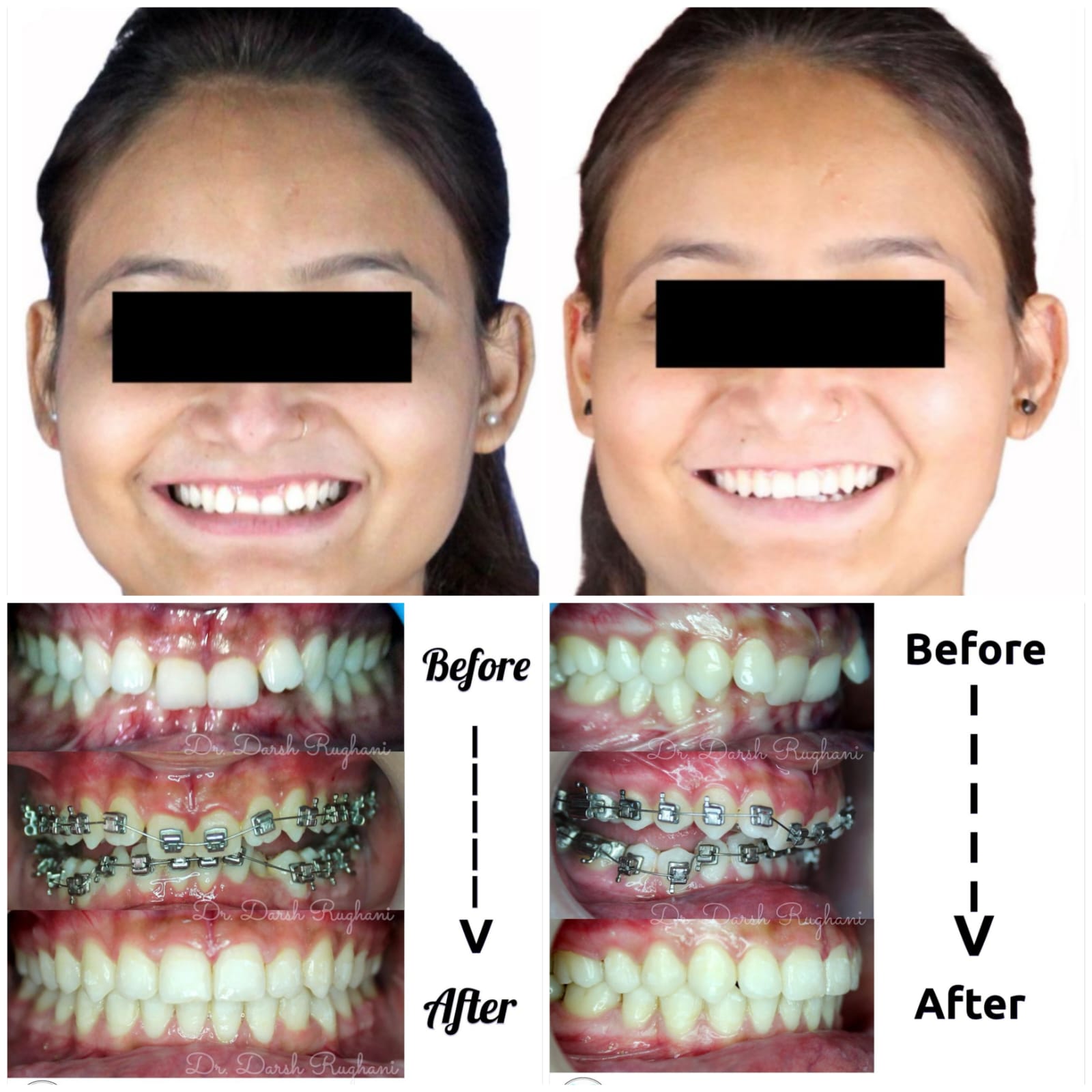Braces are dental appliances that correct problems with your teeth such as crowding, crooked teeth, and out-of-alignment teeth. Braces are commonly worn by teenagers, but they can also be worn by adults. Braces gradually straighten and align your teeth so that you have a normal bite as you wear them. Some people wear braces to straighten their teeth.
While many general dentists can perform basic tooth alignment and treat other dental problems, orthodontists specialize in teeth straightening. After dental school, a dentist studies and trains as an orthodontist for two to three years. Dr. Vishal MDS, MFD RCSI (UK), MFDS RCPS (UK) is a dental specialist who specializes in teeth straightening, bite correction and jaw disorders.
Our orthodontist will ask you health-related questions, perform a clinical examination, digitally scan your teeth, photograph your face and teeth, and arrange mouth and head X-rays. We’ll devise a treatment based on this information.
Braces are typically worn for one to three years after they are placed. For the first six months after braces are removed, most people must wear a retainer at all times. After that, you must only wear it when sleeping, but you can do so for many years.
The amount of time it takes to get braces differs from person to person. It is dependent on:
The orthodontist will carefully clean your teeth when your braces are removed. They may want to take further X-rays and bite imprints to see how well the braces worked and if you’ve developed any wisdom teeth. If your wisdom teeth start to erupt after your braces are gone, your dentist or orthodontist may recommend that you have them extracted to keep your newly aligned teeth from slipping.
A retainer, which is a vital aspect of post-braces maintenance, will be fitted by your dentist or orthodontist. Even if braces have effectively straightened your teeth, the bones, gums, and muscles must adjust to the alteration before they are entirely established in their new position. Teeth also have a tendency to move over time. As a result, the length of time a retainer should be worn varies from person to person.


Before making the dental bridge, the teeth at the outer edges of the lost area are reduced in size to let the dental bridge fit on them properly. Similar to a dental crown, the impression of your bite is taken and based on that the exact shape for the dental bridge is made. Till they are prepared, we will use temporary dental crowns or dental bridges for covering the prepared teeth.
Traditional metal braces are more effective at treating extreme overcrowding than other options like clear braces or Invisalign aligners and are the most economical optionThe main disadvantage of traditional braces is the metal mouth appearance. But , today’s braces are more visually appealing than in past years, with a range of colour options for both the brackets and the elastics.
For image-conscious teenagers, working professionals, and others who don’t want to draw extra attention to their dental work in progress, lots of nearly invisible options are available.Lingual braces have the same components as conventional braces, but they’re fixed to the back of your teeth, on the tongue — or lingual — side of the teeth. Because they’re behind your teeth, they’re nearly invisible.At your first appointment, your orthodontist will examine your teeth and discuss which treatment options are mostly likely to work well for you. If you’re interested in lingual braces, talk to your orthodontist early in the process.
Invisalign is a form of braces that use clear tray aligners. These are Removable during treatment and allows you to brush and floss easily after removing your alignersInvisalign uses a series of aligner trays that are replaced every one to two weeks. Each replacement tray will feel slightly different, as it’s designed to continue shifting and moving your teeth.To get Invisalign, you first need to have a consultation with your dentist. They’ll look at your smile, your overall oral health, and take impressions of your mouth. Then, Invisalign makes their aligners unique to your mouth for a custom fit. Your dentist creates your overall treatment plan and serves as your partner in getting the results you want.
Ceramic braces are similar to metal braces, but they use clear or tooth-colored brackets rather than gray or metallic silver brackets and wires.Many people opt for ceramic braces because they’re less noticeable on your teeth than metal braces. This can be a huge advantage if you’re considering braces and don’t want to feel self-conscious about wearing them. ProsThey’re less visible than metal braces. The ceramic material used in these braces can be either clear or tooth-colored. They move teeth faster than clear aligners .You can choose your colors. Ceramic braces are available in nearly any color imaginable.
They’re more expensive than metal braces.
They may cause gum sensitivity. Ceramic brackets are larger than metal brackets. This can make it harder to clean around your brackets, leading to swollen gums or receding gums.
They move teeth slower than metal. Because they’re more fragile, having to repair broken brackets or make incremental adjustments at each appointment can delay the straightening process.
They’re slightly less durable than metal. Ceramic braces are more than twice as likely to break .
The process of removing the glue (debonding) has also been known to cause damage to your tooth surface (enamel).
They may stain. The elastic ties holding the wire to the brackets can stain easily and remain stained until they’re replaced.
You should brush your teeth four times a day. Once after each meal and then again before you go to bed.
In general every six to eight weeks, we will tell you specifically how often is right for you. Skipping appointments can hinder your progress.
Avoid sticky, chewy foods, like caramel, and hard candy, as well as very crispy or crunchy foods, like pizza crust and fried chicken. These can damage braces and wires.
Taking care of your braces is just as important as brushing and flossing your teeth. It's important to regularly attend your scheduled appointments so the brackets don't break or wear out. Extra time and care around the brackets is recommended.
Approximately 4 weeks following bonding, you should detect slight movements in your teeth. Greater shifts that are more visible require more time as they become noticeable after approximately 2-3 months
Jal Microscopic Dental Clinic & RCT Hub is a one stop dental care clinic located conveniently and equipped with the finest technology at par with the international standards.